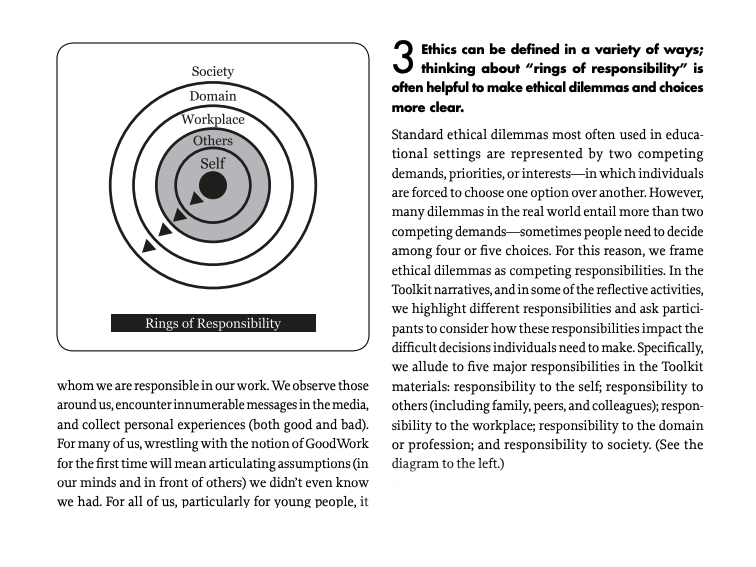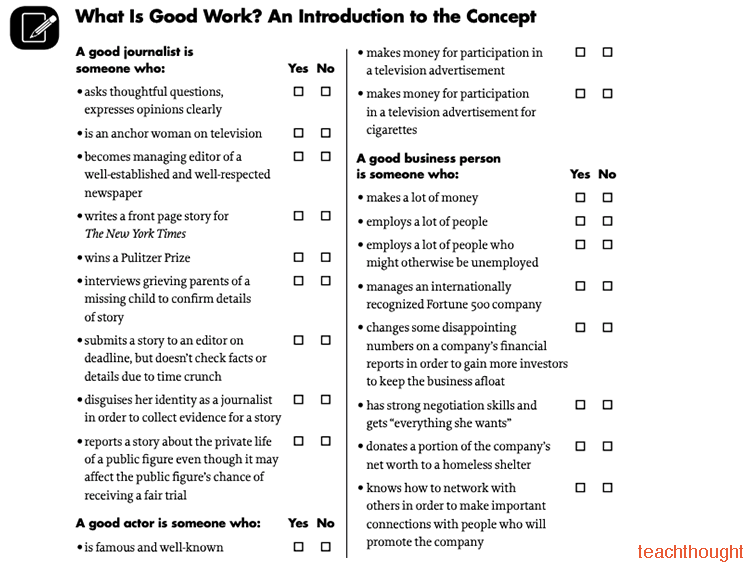
Here’s A Free Tool Kit From Harvard’s Project Zero To Incorporate Good Work Into Your Curriculum
by Terry Heick
Good work is central to TeachThought’s approach to teaching and learning.
It’s part of the ethos of our Inside-Out School model and central to critical literacy. It’s also a recurring theme in Wendell Berry’s work (a Kentucky author who has deeply influenced my own thinking on education and life). In 2015, I wrote about the concept of Good Work as it relates to students in ‘Preparing Students For Good Work.“
Recently, I began a dialogue with Danny Mucinskas from The Good Project at the Harvard Graduate School of Education about ways to support this effort. There is significant overlap between the goals of The Good Project and TeachThought and anything I can do to help this kind of thinking find traction, I’m all for.
The Good Project began twenty years ago as an investigation of the meaning of “good work,” and researchers have carried out over 1200 interviews with professionals across many domains to find that “good work” is defined by three dimensions: it is excellent (carried out well), engaging (meaningful), and ethical (attentive to moral codes and effects on others).
To start out, we’re going to share one of their resources called the GoodWork Toolkit (which you can access here).
The GoodWork Toolkit is, in short, a resource kit for educators meant to help people reflect on the meaning of good work. It’s 160+ pages long and represents an in-depth analysis of the topic. You can read more about the tool kit in the words of those who developed it below.

The GoodWork Toolkit Explained By The Good Project
Work occupies much of our lives. Hours spent at the office or at home thinking about work-related tasks and obligations often exceed time away from work. Yet, how many of us find our work meaningful? How many of us feel able to do our best work? And how often do we stop to consider the consequences of our work on others or its impact on society as a whole?
For individuals at all levels (young students, graduate school students, and new and veteran professionals), opportunities to consider the meaning of work for themselves and others are rare but imperative. Society needs professionals who care about good work.
The GoodWork Toolkit is an approach to engage individuals and groups in reflection and conversation about good work. The Toolkit consists of a flexible set of materials, including vignettes of individuals who struggle to carry out good work, and accompanying questions and activities. Since 2007, educators at all levels—elementary school to graduate school—from around the world have implemented these materials in their coursework in a variety of ways.
The Toolkit is not a prescribed curriculum; it is called a “toolkit,” because it contains a variety of tools” that may be used in a number of combinations. The materials are meant to be adaptable to a variety of contexts; in other words, the Toolkit can be used as part of a retreat, as a year-long theme in a particular class, as the basis of a two or three-day seminar. There is no need to follow these chapters, in order, from beginning to end. Facilitators should feel free to pick and choose and adapt these cases and activities as best suits their goals and needs.
The Guidebook is a resource manual to help participants start important conversations and reflection about good work.
The Narratives volume is a separate collection of the same real-life stories included in the Guidebook but limited to the cases themselves.
The Value Sort Cards encourage participants to think about their personal and professional values.
For 20 sample lesson plans to use concurrently with the GoodWork Toolkit, click here.
For a sample rubric that can be used with pre- and post-assessments of concept understandings, click here.
Finally, you can follow The Good Project on Facebook here.
The Good Project wants to hear from you! Please write to [email protected] if you find these materials of interest or use them in any way.
